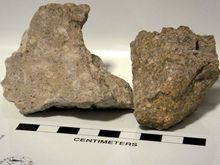

Ignimbrite is a type of volcanic rock, consisting of hardened tuff.[1] Ignimbrites form from the deposits of pyroclastic flows, which are a hot suspension of particles and gases flowing rapidly from a volcano, driven by being denser than the surrounding atmosphere. New Zealand geologist Patrick Marshall (1869–1950) coined the term ignimbrite from the Latin igni- [fire] and imbri- [rain].
Ignimbrites are made of a very poorly sorted mixture of volcanic ash (or tuff when lithified) and pumice lapilli, commonly with scattered lithic fragments. The ash is composed of glass shards and crystal fragments. Ignimbrites may be loose and unconsolidated, or lithified (solidified) rock called lapilli-tuff. Near the volcanic source, ignimbrites often contain thick accumulations of lithic blocks, and distally, many show meter-thick accumulations of rounded cobbles of pumice. Ignimbrites may be white, grey, pink, beige, brown, or black depending on their composition and density. Many pale ignimbrites are dacitic or rhyolitic. Darker-coloured ignimbrites may be densely welded volcanic glass or, less commonly, mafic in composition.
- ^ Le Maitre, R. W., ed. (2002). Igneous Rocks: A Classification and Glossary of Terms. New York, United States: Cambridge University Press. p. 92. ISBN 978-0-511-06651-1.